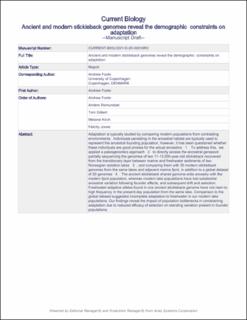| dc.contributor.author | Kirch, Melanie | |
| dc.contributor.author | Romundset, Anders | |
| dc.contributor.author | Gilbert, Marcus Thomas Pius | |
| dc.contributor.author | Jones, Felicity C. | |
| dc.contributor.author | Foote, Andrew | |
| dc.date.accessioned | 2021-04-22T09:00:41Z | |
| dc.date.available | 2021-04-22T09:00:41Z | |
| dc.date.created | 2021-04-20T18:41:16Z | |
| dc.date.issued | 2021 | |
| dc.identifier.issn | 0960-9822 | |
| dc.identifier.uri | https://hdl.handle.net/11250/2739031 | |
| dc.description.abstract | Adaptation is typically studied by comparing modern populations with contrasting environments. Individuals persisting in the ancestral habitat are typically used to represent the ancestral founding population; however, it has been questioned whether these individuals are good proxies for the actual ancestors.1 To address this, we applied a paleogenomics approach2 to directly access the ancestral genepool: partially sequencing the genomes of two 11- to 13,000-year-old stickleback recovered from the transitionary layer between marine and freshwater sediments of two Norwegian isolation lakes3 and comparing them with 30 modern stickleback genomes from the same lakes and adjacent marine fjord, in addition to a global dataset of 20 genomes.4 The ancient stickleback shared genome-wide ancestry with the modern fjord population, whereas modern lake populations have lost substantial ancestral variation following founder effects, and subsequent drift and selection. Freshwater-adaptive alleles found in one ancient stickleback genome have not risen to high frequency in the present-day population from the same lake. Comparison to the global dataset suggested incomplete adaptation to freshwater in our modern lake populations. Our findings reveal the impact of population bottlenecks in constraining adaptation due to reduced efficacy of selection on standing variation present in founder populations. | en_US |
| dc.language.iso | eng | en_US |
| dc.publisher | Elsevier | en_US |
| dc.rights | Attribution-NonCommercial-NoDerivatives 4.0 Internasjonal | * |
| dc.rights.uri | http://creativecommons.org/licenses/by-nc-nd/4.0/deed.no | * |
| dc.title | Ancient and modern stickleback genomes reveal the demographic constraints on adaptation | en_US |
| dc.type | Peer reviewed | en_US |
| dc.type | Journal article | en_US |
| dc.description.version | acceptedVersion | en_US |
| dc.source.journal | Current Biology | en_US |
| dc.identifier.doi | https://doi.org/10.1016/j.cub.2021.02.027 | |
| dc.identifier.cristin | 1905394 | |
| dc.description.localcode | "© 2021. This is the authors’ accepted and refereed manuscript to the article. Locked until 10.3.2022 due to copyright restrictions. This manuscript version is made available under the CC-BY-NC-ND 4.0 license http://creativecommons.org/licenses/by-nc-nd/4.0/ " | en_US |
| cristin.ispublished | true | |
| cristin.fulltext | postprint | |
| cristin.qualitycode | 2 | |

